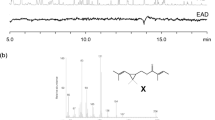Summary.
The diterpene neocembrene A or (1E,5E,9E,12R)-1,5,9-trimethyl-12-(1-methylethenyl)-1,5,9-cyclotetradecatriene, known as the trail-following pheromone of the advanced Termitidae Nasutitermitinae Nasutitermes exitiosus and Trinervitermes bettonianus, has been identified after SPME-GC/MS as the major component of the trail-following pheromone of the Rhinotermitidae Prorhinotermitinae, Prorhinotermes canalifrons and P. simplex. In all the other Rhinotermitidae studied until now, the major component of their trail pheromones is dodecatrienol ((3Z,6Z,8E)-dodeca-3,6,8-trien-1-ol). This biochemical data further add to the anatomical and molecular characteristics that give a special status to the taxon Prorhinotermes among Rhinotermitidae. In Prorhinotermes canalifrons and P. simplex, neocembrene A was the only secretory compound specific to the sternal gland surface that could be detected after SPME. It elicited orientation as well as recruitment behavioral effects. However, the comparison of the respective biological activities triggered by neocembrene A and by sternal gland secretion suggests that minor components of the latter are acting in synergy with neocembrene A.
Similar content being viewed by others
Author information
Authors and Affiliations
Corresponding author
Rights and permissions
About this article
Cite this article
Sillam-Dussès, D., Sémon, E., Moreau, C. et al. Neocembrene A, a major component of the trail-following pheromone in the genus Prorhinotermes (Insecta, Isoptera, Rhinotermitidae). Chemoecology 15, 1–6 (2005). https://doi.org/10.1007/s00049-005-0285-9
Received:
Accepted:
Issue Date:
DOI: https://doi.org/10.1007/s00049-005-0285-9




